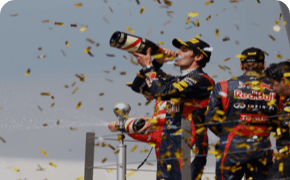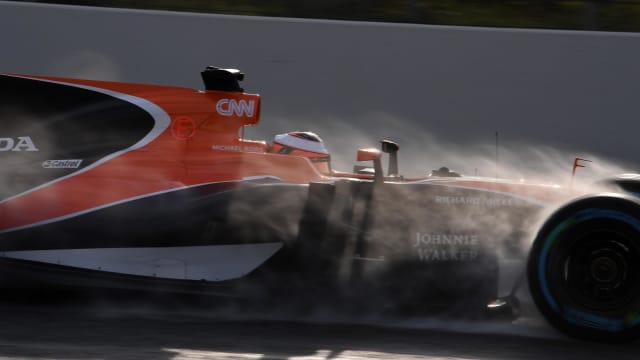Mercedes still the team to beat…
Yet again, Mercedes have kicked off the year in nothing short of spectacular fashion, not only setting the outright pace through nicely-settled-in new recruit Valtteri Bottas, but also completing significantly more laps than their rivals (558 over four days, the equivalent of more than eight Spanish Grands Prix).
That they managed to complete several full race simulations and a good deal of aero experimentation within that tally only emphasised how smoothly everything went - even when they did eventually hit trouble on the final day, they still recovered to complete 68 laps.
What’s more, Lewis Hamilton seems to be getting on famously with new team mate Bottas, saying: “We already have a better working relationship than I ever had with any team mate I had before.”
Ominous signs then, and what’s more, the Silver Arrows have promised there is plenty more to come.
Valtteri Bottas (FIN) Mercedes-Benz F1 W08 Hybrid at Formula One Testing, Day Four, Barcelona, Spain, 2 March 2017. © Sutton Images
…but Ferrari in better shape than last year
Last year Ferrari topped three of the first four days of testing. This year they topped two - but you’d be hard pressed to find anyone inside the team or out who would argue against the Scuderia being in a better position now than they were 12 months ago.
Not only have initial times been promising (while generally circulating on harder tyres than rivals Mercedes), but the SF70H has shown strong reliability, while out on track it looks a more stable and balanced machine than its predecessor.
Does that mean the Prancing Horse is on course to take the fight to the Silver Arrows? “We will see,” said Kimi Raikkonen, “but the first feelings are good, and that’s the main thing. We know what we are doing, and we are reasonably happy with how things are running. Some years it runs smoothly, some years not - and this year has been good so far.”
It has to be said that last year’s strong test showing foreshadowed a season in which Ferrari failed to win a single race. Their progress in the second test should give us a better idea of which way they will go this year.
Sebastian Vettel (GER) Ferrari SF70-H is pushed by the marshals in pit lane at Formula One Testing, Day Three, Barcelona, Spain, 1 March 2017. © Sutton Images
Red Bull keeping cards close to their chest
In typical fashion Red Bull were giving little away in Spain. As usual, there seemed to be little concern about setting headline lap times - Daniel Ricciardo’s best was almost 1.5s down on Valtteri Bottas’ benchmark. Neither did they rack up huge mileage, as various technical niggles restricted their running at times. But despite this, there was an air of calm and quiet confidence in the Milton Keynes camp.
“If you start on a highly complicated level it is so easy to get lost,” said technical chief Adrian Newey of the RB13’s design, confirming suggestions that the car is definitely still in its infancy in terms of development potential.
“In general everything behaved pretty well,” was Max Verstappen’s take. “I think Mercedes might still have an advantage on us in terms of power at the beginning of the season but we’ll be catching up.”
Few would bet against it.
Max Verstappen (NED) Red Bull Racing RB13 at Formula One Testing, Day Four, Barcelona, Spain, 2 March 2017. © Sutton Images
There is more time to extract from the new cars
Formula One racing’s new breed of cars were faster than their 2016 counterparts straight out the box in Barcelona. Bottas’s headline time of 1m 19.705s was, for example, well over 2s quicker than Lewis Hamilton’s 2016 pole lap - and more than 3s better than anything anyone managed in pre-season last year.
But there’s plenty more to come. F1’s official tyre suppliers Pirelli estimate that we will see times move into the 1m 18s bracket in the second week of testing, as teams introduce new updates and also begin to focus more specifically on single-lap pace.
We saw no end of aero experimentation this week, with shark fins, T-wings, double T-wings etc, but by the time this year's Spanish Grand Prix comes around in May, a whole new raft of developments will be in place as teams build their knowledge and exploit new opportunities arising from the revised regulations.
The all-time fastest lap posted on the current layout of the Circuit de Barcelona-Catalunya is a 1m 18.339s, posted by Felipe Massa in 2008 testing. By May, that benchmark may well be eclipsed
T-wings on (clockwise) the new Williams, Haas, Ferrari and Mercedes at this week's Barcelona test © Sutton Images
A mountain to climb for McLaren and Honda
At McLaren’s 2017 car launch last week there was talk of a brighter - indeed an orange - future, after what has been a tough first two years of their revived Honda partnership. But after Barcelona, the atmosphere in Woking will surely be more muted. Only on day three did the team manage a lap count above 50, as first an oil tank design fault and then another unresolved issue prompted power unit changes.
It’s no secret that Honda have revised their engine architecture this year along similar lines to Mercedes', but any suggestions that power output may be on par with that of the world champions definitely look to be wide of the mark.
Added to the fact that the MCL32 did not look particularly comfortable on track, it all meant a rather frustrating time for Fernando Alonso and new team mate Stoffel Vandoorne, while racing director Eric Boullier was left to bear the brunt of the media’s questioning.
“In a much better situation!” he told F1.com, when asked to compare this first test to those of 2015 and ’16, adding: “But to be frank it is not good enough for our expectations and the expectations of our fans - after three years!”
Stoffel Vandoorne (BEL) McLaren MCL32 at Formula One Testing, Day Four, Barcelona, Spain, 2 March 2017. © Sutton Images
Toro Rosso need a big second test
"All in all, it’s been a bit of a bumpy ride to begin with," team principal Franz Tost conceded after Toro Rosso finished bottom in terms of mileage run. "We were hoping to have completed many more laps. We couldn’t complete our programme because of some reliability issues - [and] therefore we are missing some data.
"But we are confident that we will get everything under control next week during the second test in order to be ready for the first race of the season in Australia. When the car has been out on track we’ve got a very promising feedback..."
As Tost himself put it, Toro Rosso finished the first test with mixed feelings. The car's complexity and innovative touches - not to mention the new livery - drew some admiring nods when it was unveiled, but so far reliability has hampered the team from finding out whether good looks translate into good performance.
Between them, Daniil Kvyat and Carlos Sainz managed just 183 laps over the four days. Valtteri Bottas, by contrast, did nearly double that by himself. When every lap means data, that's a big loss for Toro Rosso - and while it's by no means insurmountable, a repeat performance next week would leave the team decidedly on the back foot.
Carlos Sainz (ESP) Scuderia Toro Rosso at Formula One Testing, Day Four, Barcelona, Spain, 2 March 2017. © Sutton Images
High tyre degradation might be a thing of the past
For 2017 Pirelli were asked to make their new, wider tyres not only faster, but also more durable - so that drivers can push to the maximum for longer. And by all accounts they seem to have delivered. Data suggests a performance loss over 20 laps of around 1 to 1.5s lap time, compared to 4 or 5s last year, with drivers also more able to ‘recover’ a tyre should they overheat it.
This could, of course, mean more one-stop races - something not everyone is keen on. It should be noted, however, that conditions in Spain were notably cooler than those the teams will encounter during the season, hence not entirely representative. What is certain is that the tyres are definitely quicker.
“The target was for lap times that were five seconds faster compared to Barcelona in 2015,” said Mario Isola, Pirelli Racing Manager. “Valtteri Bottas set a best time of 1m19.705s on ultrasoft tyres. Considering that the pole time in 2015 at Barcelona was 1m24.681s, I would say that this objective has been met.”
Pirelli’s wet-weather tyre changes were also deemed a success, after the teams trialled them using an artificially-dampened track on the final day. New dimensions and tread patterns mean the wet compound now expels 85 litres of water per second at 300km/h rather than 65, and the intermediate 30 rather than 25. Definitely more grip was the drivers' conclusion, albeit with an inevitable increase in spray.
Pirelli tyres at Formula One Testing, Day One, Barcelona, Spain, 27 February 2017. © Sutton Images
Stroll and Williams still with much to learn
Lance Stroll suffered something of a baptism of fire in Barcelona, with three incidents in two days emphasising the steepness of the learning curve that the Canadian teenager faces as he tries to come to terms not only with the step up to F1, but also with the brutal new machinery introduced this year.
That Stroll’s final off ended Williams' participation at the test a day early was unfortunate, because it was by no means a major crash. Nor should any rookie - especially one so young - be expected to be completely error free.
Perhaps that’s why Williams were so quick to absolve Stroll of any blame, with Rob Smedley saying the 18-year-old was an ‘innocent victim’ and that the onus was on the team to get the car and tyres working in better harmony, even in tricky conditions.
That said, with just 213 and 110 laps under their belts respectively, the pressure is now on for Williams and Stroll to make up for lost time at the second test and, more importantly, not to make the same mistakes again.
Lance Stroll (CDN) Williams at Formula One Testing, Day Three, Barcelona, Spain, 1 March 2017. © Sutton Images



















